|

A BIT OF HISTORY: "...I am doing
historical research on VJ/VU Utility Sqs and those VU Utility Sqs redesignated VC Fleet
Composite Sqs as well as Marine VMJ Utility Sqs. I served with VJ-1 10 Apr 42-2 Jun 47 as
AMM2C. VJ-1 was estabilished Oct 25 at NAS San Diego NAS North Island, San Diego,
California) In Jun 40 the Sq embarked on the USS York Town for duty atNAS Pearl Harbor,
Hawaii (Ford Island) and was there along with VJ-2> on 7Dec41. VJ-1 had JRS-1s
Sirkorsky twin eng flying boats & J2F Grumman Ducks &>VJ-2 had PBY-1 Catalines
which required beaching gear & also had J2Fs. VJ-1 got a JRS airborne with Marines
with rifles aboard for firepower. They ran into a stray Jap acft but somehow managed to
evade it. Luckily they didn't find the Japanese Fleet. In Apr 43 the Sq split and formed
VJ-9 which went to Espertos Santos with PV1s. In Apr 44 sent a det VJ-1A to Majuro with
JMs Martin Marauders painted chrome yellow and stripped down for towing to provided towing
for the fleet staging there for the Guam push. Det relieved by VJ-17 end Jun& returned
to Pearl. VJ-1 relieved at Pearl 31Jul44 and embarked on USS Bismarck Sea for NAS Point
Mugu, California reporting back for duty at NAS Moffett Field, California o/a 6Sep44
relieving VJ-18. I came to Goleta MCAS now Santa Barbara Arpt 10ct44 Det VJ-1A. Our
primary msn was towing for fleet gunnery school at a NAS Point Mugu, California &
Marine Gunney School. After VJ Day we folded our operation & returned to NAS Moffett
Field, California. Sq embarked on new USS Block Island 19Oct45 for return to Pearl. On
15Nov46 all VJ Sqs redesinated VU Sqs. In Jul47 VU-1 moved to NAS Barbers Point, Hawaii
operating until Apr49 when disestablished and it personnel trsfrd to VU-7A. In Jul51 VU-1
was reestablished from VU-7A personnel & acft. On 1Jul65 all existing VU Sqs were
redesignated VC Fleet Composite Sqs. VC-1 continued to operate at NAS Barbers Point,
Hawaii until being disestablished 29Sep92. NAS Barbers Point, Hawaii being deactivated in
99. Any historical input will be sincerely appreciated. As we say in Hawaii Mahalo Nui
Skinny..." Contributed by Bryant "Skinny" Fleming vj-1@webtv.net [18NOV98]

GRUMMAN DUCK J2F-6
The Grumman JF/J2F Duck is a small utility amphibian with a center float,
wing floats and retractable landing gear. Nine versions of this particular airplane, which
first appeared in 1933, have been built for the US Navy and Coast Guard. It was used for
photography, target-towing, scouting and rescue work throughout World War II. |
The JF-1(s) served in VJ-1 attached to the
USS WRIGHT with utility units aboard the USS SARATOGA, USS LEXINGTON, USS RANGER, and
aboard the USS HERON in the Asiatic Fleet. The JF-2 (Design 9) was built in 1934-35 as an
unarmed utility aircraft for the U.S. Coast Guard. The JF-1 of VJ-1 carried Green tail
surfaces and main float tip. VJ-1 was the primary user of JF-1(s).

A JF-2 Duck of VJ-1 stationed
at Pearl Harbor, Territory of Hawaii during 1939. |
|
"...My name is Terry Reynolds TLR2FAST@AOL.com
and I work for a company in Wichita, Kansas called Wichita Air Services Inc. Our company
restores WW 11 aircraft and we are currently restoring a piece of history! We are
restoring to flying condition a Grumman J2F-4 Duck! It is serial number 1649 and was
assigned to VJ-1 on December 7th 1941 and we are very interested in the history of this
aircraft . If you would be able to contact us or put us in contact with anybody who was in
the squadron at the time...We are most interested in the events of 12-7-41 involving VJ-1
, and are in need of any photo's that might be available of this or any aircraft in the
squadron so we might accurately reproduce the markings/colors it wore. This aircraft was
recovered from the bottom of a lake where it had been since a landing accident in 1955.
Much work has been completed to date four new wings ,ailerons , new elevators and rudder
have been fabricated using origonal parts where possible. The fuselage is about 90%
complete and the hull is about 40% rebuilt todate, we were able to find an original
1820-30 engine and it is being overhauled...We would like to hear from you. Wichita Air
Services Inc., 1880 Airport Road, Wichita, Kansas...Sincerely yours, Terry Reynolds Terry
Reynolds TLR2FAST@AOL.com..." |
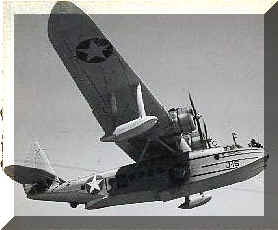 |
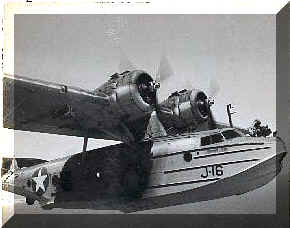 |
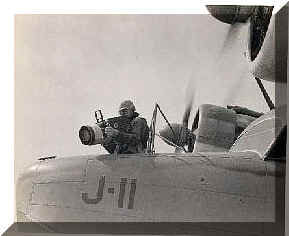 |
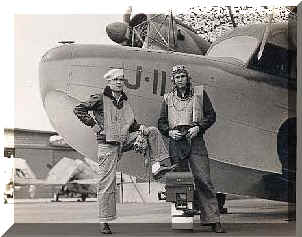 |
| Photos coutersy of Bryant "Skinny" Fleming
|

SKIRKOSKY
JRS-1 FLYING BOAT |
| S/N |
REG. |
MARKINGS |
STRICKEN |
REMARKS |
| 4329 |
#0504 |
1-J-1 |
11-43 |
To VJ-1RIGEL 7-37. Pearl Habror 7-41. NAS San Diego 11-42. To VJ-1
7-43. |
| 4330 |
#0505 |
1-J-2 |
|
To VJ-1 San Diego. Crxd 12-31-38. |
| 4331 |
#0506 |
1-J-3 |
11-43 |
To VJ-1 San Diego. To PH detachment of VJ-1 8-40. |
| 4338 |
#1055 |
|
7-23-43 |
To VJ-1 San Diego RIGEL 6-6-38. |
 |
Sikorsky
JRS-1
Type: utility transport
amphibian flying boat
Crew: 3-4, with 15 passengers
Armament: none
Specifications:
Length: 51' 2" (15.60 m)
Height: 17' 8" (5.38 m)
Wingspan: 86' 0" (26.21 m)
Wing area: 780.6 sq. ft (72.52 sq. m)
Empty Weight: 12,750 lb (5783 kg)
Max Weight: 19,096 lb (8662 kg) max at takeoff
Propulsion:
No. of Engines: 2
Powerplant: Pratt & Whitney R-1690-52 Hornet radial
Horsepower: 750 hp each
Performance:
Range: 775 miles (1247 km)
Cruise Speed: 166 mph ( 267 km/h) at 7000 ft
Max Speed: 190 mph ( 306 km/h) at 7000 ft
Ceiling: 20,700 ft (6310 m) |
Stearman-Hammond
JH-1
In 1936 the Navy began another drone program which was
intended to provide realistic targets for antiaircraft gunnery practice but which directly
influenced missile development. Lieutenant Commander (later Rear Adm.) D.S. Fahrney was in
charge of the project. The plane used was a Stearman-Hammond JH-1, and the radio control
equipment was again developed by the Naval Research Laboratory. This drone made its first
successful flight Nov. 15, 1937. The following summer such a drone was first used for
target practice by the antiaircraft batteries of the USS Ranger. (July 21,
1936: Lt. Comdr. D. S. Fahrney (USN) ordered to implement recommendation made to Chief of
Naval Operations to develop radio-controlled aircraft for use as aerial targets. Reporting
to BuAer and NRL, Fahrney subsequently reported on procedure to obtain drone target
planes, but also recognized the feasibility of using such aircraft as guided missiles. )
Hammond JH 1937 = USN version of Y-1S with similar
specs and data. POP: 2 as JH-1 [0908/0909]. Tests with two Stearman-Hammond JH-1s were
very secret at the time and little has been published about them. They were painted
yellow, the standard for primary trainers, and classified as Utitlity (J) planes to hide
their identity as one of the very first radio-controlled aircraft in the USN. Both planes
were tested as unmanned drone targets for anti-aircraft fire, and both were assigned to
Utility Squadron One (VJ-1). Rumors had it are that both were shot down, but there is no
confirmation of this, and the aircraft history card for [0908] simply says "crashed
Nov 7, 1938," and [0909] was stricken off on Sep 13, 1938, according to a
Confidential letter from the Officer in Charge of Radio-Controlled Aircraft, Base Force,
Utility Wing.

Hammond Y-1S (Y-150) 1937 (644) = 2pClwM; 150hp Menasco
C-4S; span: 40'0" length: 26'11" load: 768# v: 130/121/39 range: 480. Improved
Y-125. About $5,000; POP: 14, [NC15521/15533, PHAPY], of which 2 to USN as JH-1. Project
was dropped in 1938 because of buyer reluctance over high price.
(Anyone have any additonal info on the JH-1??) |
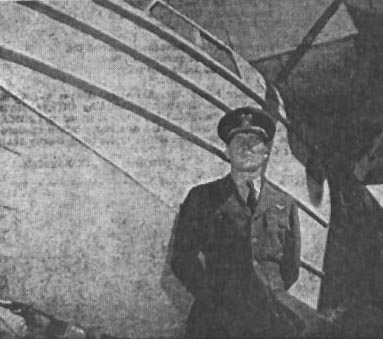
|
MOFFET FIELD 1944-45
Lieut. Emory C. "Pappy" Geise,
USN, is shown here beside the antiquated Sikorsky amphibian in which he outran a Jap Dive
bomber on December 7, 1941. It was in this plane that he volunteered to take off during
the second attack to search for the enemy fleet. Two hundred and fifty miles out the Jap
plane made a diving pass on him and chased him low over the waves for eight minutes at
more than 180 knots, which is an exceptional speed for the amphibian. The crew for
protection had only two Springfield rifles which they had trained on the enemy through
side hatches. It is an interesting coincident that when "Pappy" recently arrived
here with Utility Squadron 1, check of the bureau number of the old JRS sitting beside
hanger 1 proved to be the identical plane that gave his harrowing experience four years
ago. ("Pappy went on to become Executive Officer in 1945. |

|
MAY
1941 IN FRONT OF JRS-1 |
| 11 SETS OF BROTHERS:
left to right, back row, Raymond J. Vaughn, Sea2c; Albert Gallupe, AMM3c; Orvile W. Myles,
AMM3c; Harold Rich, AMM3c; Homer C. Barnwell, Jr. Sea1c; William A. Gilbert, Sea2c; Roy F.
Gilmore, AMM1c, NAP; Wylie M. Henderickson, AMM3c, Robert L. Clayton, Sea2c; Henry H.
Schffner, AMM3c, and John C. Ruthroff, Sea2c. Left to right, front row, Enoch E. Vaughn,
Sea2c; Amos P. Gallupe, Jr. AMM2c; Clyde W. Myles, CRM (AA); John F. Rich, RM3c; Willis K.
Barnwell, Sea1c; Clarence E. Gilbert, Sea1c, James W. Gilmore, Sea2c, Arthur E.
Hendrickson, AMM3c; Harold M. Clayton, Sea2c, Clarence A. Schaffner, AOM2c, Clyde L.
Ruthroff, RM3c. |
11 Sets of Brothers in One
Pearl Harbor Navy Unit
By
CHARLES M. HATCHER
To start with the navy is one great brotherhood.
Not
only do the men-o-warsmen out on the fighting ships feel that they’re units in a
superb fighting machine but there’s an esprit de corps which makes every man in every
crew feel he’s a member of a huge family, pledged to a dynamic cause.
More
than this, now, is the spirit which
prompts men to urge their own relatives to join, their navy, and in VJ Squadron 1, naval
air station, Pearl Harbor, you’ll find this, feeling evidenced by the 11 sets of
brothers now attached to that unit.
Yessir, 11 c o m pl et e
sets of signed papers in San Diego, with
more combinations possible as soon as boys now in training or awaiting call by the navy
can be transferred here!
This
appears to set some sort of record in the navy for an organization with so small a roster.
VJ-Squadron
1's brother couplets enlisted from hometowns scattered literally the length and breadth of
the country.
The
Myles and Gallupe boys signed papers in San Diego, while the Rich brothers enlisted in Boston. Texas produced two
sets, with the Vaughns hailing from Houston; the Barnwell’s from Dallas. Incidentally
these Texans seem to be full inheritors of the original scrappy Texas temperaments.
California
registers again with the Gilbert youngsters, and Des Moines, Ia, hits the bulls eye
properly with not one, but two, couples, the Clayton and Ruthroffs. The Schaffners
nodded for the recruiter in Denver; the Hendricksons at Portland, Ore.
The
Gilmore pair from Alabama were choosy, enlisting from Pensacola, Fla., and Birmingham,
Ala.
Illustrative
of the divergence apparent. in men, even in families, is the fact that the various
brothers are heading for a number of: different ratings instead of following dual
grooves. Most of the men are aiming at aviation machinist mate and radio jobs. One of the
group, Roy Foster Gilmore, is a naval aviation pilot.
The
slogan seems to be, “If we’re gonna fight, let’s make it a family
scrap!”
|
|